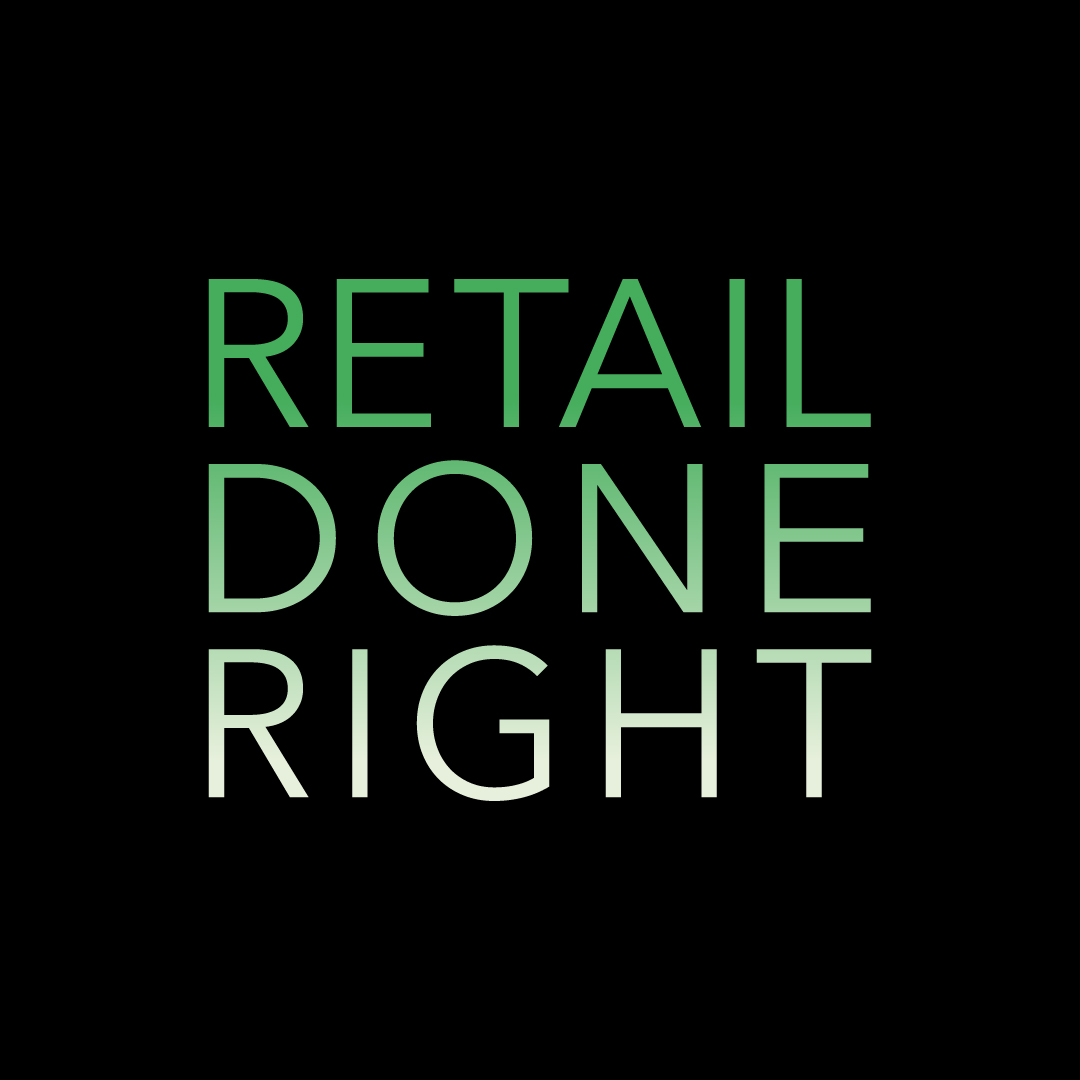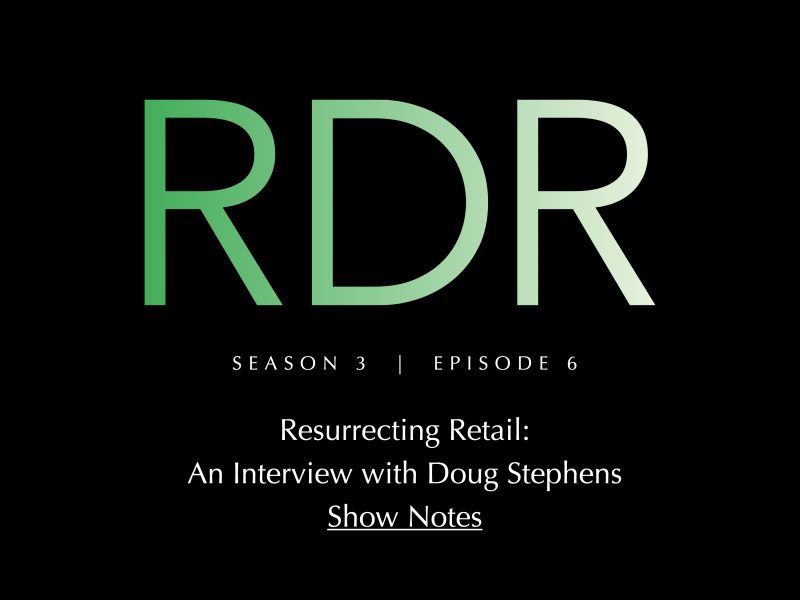INTRODUCTION
We welcome Doug Stephens, Founder and CEO of the global advisory firm Retail Prophet to Retail Done Right. Doug is a retail futurist and best-selling author of 3 books, including his newest, “Resurrecting Retail.” His perspective is grounded in fact, yet far reaching. And we cover a lot of ground in this interview. From people to product, and especially experience, from online lessons that brick-and-mortar retailers need to learn to born-digital ecommerce player’s desire to build physical stores. So much thought-provoking content.
Physical stores will stay relevant and become more strategic for retail organizations if they are no longer managed as points of sale. Stores are the most effective tool to acquire and engage customers, becoming more like media networks. They have also been transformed into logistics, service and experience hubs.
Retail organizations need to shift from a product and operations forum into truly customer-centric business models that will demand new KPIs and new ways to measure the contribution of the stores in attracting, retaining and engaging more customers, increasing their lifetime value.
THE CONVERSATION
We explored a variety of topics via a series of questions:
- Can you tell us about your career trajectory? We’re curious how you got to where you are today.
- How do you see the health of retail? Are retail balance sheets healthier today?
- A key idea in your latest book, “Resurrecting Retail,” is introduced in the Forward by Imran Amed, Founder and CEO of The Business of Fashion, “It’s no longer about sales per square foot and cost per click, but rather about experiences per square foot and sales per click.”
Later in the book, you write, “The key to effectively measuring the true productivity of a store is found by focusing on a metric we’re already familiar with from the marketing side of the industry…a value per media impression. In other words, determining the value of a positive brand impression delivered via a physical experience… The point is that physical retail is no longer simply a product distribution strategy – it’s a customer acquisition strategy with an inherent and attributable return of value… The question is, ‘What is the appropriate value to attribute to physical stores? It’s…one that requires two components: 1st, an internally agreed-upon value per customer impression; and 2nd,… a gauge of the quality of the average impression.’”
Would you elaborate a little more?
- There’s been a tremendous amount of press about the Great Resignation, and more recently Quiet Quitting. Retail and Hospitality are nearly double other industries in terms of defection. But high turnover isn’t necessarily new to these industries. To mix metaphors, how should we manage the front line and the bottom line?
- You talk about how, for instance, music streaming and virtual concerts are changing the live experience – possibly putting pressure on that live experience. Would you say this is also true of the retail experience? Over time will stores 1) Be able to compete effectively with digital experiences? 2) Will they be able to afford to do so on declining traffic? Feels a bit like a double whammy, no?
- Is a separate .com structure weighing orgs down? Especially due to the costs of fulfillment and shipping and delivery? In your book, you walk through the economics of this (p 91). Can you share more as the statistics were shocking?
- Cost of transportation: not just mid and last mile but acquisition of goods… Can we really afford globally produced goods on increased fuel prices and from a sustainability perspective?
- The Alibaba Freshippo example in your book is a peerless example of a digital and IRL integration. Can you describe this more?
- Might you also explore CAMP out loud for us? (p139)
- Where are the core and emerging potential economies of scale?
- What’s your opinion on what Gary Friedman has done with RH? You talk about their paid membership program, but I’m asking from a broader perspective. (pg191)
CONCLUSION
In summary, we asked Doug, if you were to offer retail executives three areas to evaluate for changes right now, what would they be? Doug summarized:
“…Number 1 is to get back to who are we and why do we, and for whom, and what is the value we create in the world? Number two, how can we ensure that this experiential media that we’re delivering to consumers every day is positive and valuable to our business? And thirdly, how can we redesign supply chains for this new disruptive era that we do business in? And I think if you can do all three of those things in your business, you’re a champion.”
HEROES & CHANGE MAKERS | Our New Feature
Our new feature, Heroes and Change Makers, concluded our discussion.
We invited Doug to select our Hero & Change Maker and his selection did not disappoint. Yvon Chouinard, founder and CEO of Patagonia.
Doug states, “…the fact of the matter is, since its inception as a business, Yvon Chouinard, who by the way is a true outdoorsman himself, really has always valued the outdoors. The raison d’être of the business has always been to stand on the front lines of environmental destruction and to try and save the planet in any way that they can. To transform the business into a charitable trust, to do just that into perpetuity, I think makes the man a hero.”
We couldn’t agree more.
This is RETAIL DONE RIGHT. Thank you for listening. And please join our conversation.
- Michael Cooke via Upwork is our brilliant sound engineer and editor – and Jade Siriswad composed our theme music.
- Please subscribe on Apple Podcasts, Spotify, or your favorite podcast platform.
- Please follow us on Instagram at retail done right and at our website https://retaildoneright.net
Let’s go shopping!
Jeff Fisher & Cristene Gonzalez-Wertz
Connect with Jeff on LinkedIn
Connect with Cristene on LinkedIn
RETAIL DONE RIGHT is produced and hosted by Jeff Fisher & Cristene Gonzalez-Wertz

